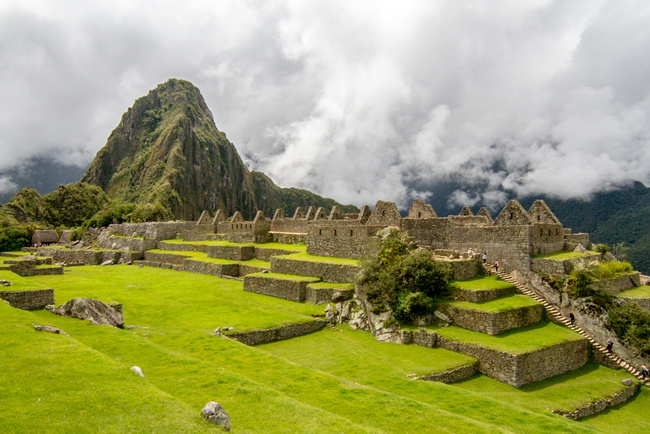
Machu Picchu
Machu Picchu is the bucket-list tourist attraction and the highlight of many peoples’ trip to Peru; the vastness, location and detail of the ruins make it unmissable. Without a doubt this is the crown jewel of Peruvian ruins.
More about Machu Picchu
The mystical citadel is perched 2592 metres high on Machu Picchu mountain, set against a vast backdrop of steep lush mountains that spike up from the deep valleys of the Urubamba and its tributaries below. Having never been discovered by Spanish conquerors, it was found relatively intact by US explorer Hiram Bingham on July 24th, 1911, making Machu Picchu a prime example of Inca architecture.
The name Machu Picchu is thought to mean Old or Ancient Mountain and most archaeologists agree that Emperor Pachacuti chose the site in the mid-fifteenth century due to its sacred geography and position for astronomy. Many archaeologists speculate that Machu Picchu’s fine stonework and temple precincts indicate its importance as an agricultural centre and the layout and quantity of the temples indicate that it was a religious centre. It boggles the mind to think exactly how the Incas managed to transport the stones up Machu Picchu mountain, but it the site’s mysterious origins that are central to its enduring appeal.
It’s easy to spend a whole day wandering the citadel, with numerous flights of steep stone steps interconnecting its palaces, temples, storehouses and terraces. The highlights are the elegant Sun Temple, the surreal Royal Mausoleum, the monolithic shrines of the Sacred Plaza and the mysteriously carved Intihuatana stone.
More energetic guests should try to get their hands on one of the 400 daily tickets to climb to the summit of Huayna Picchu, the peak which sits 2720 metres above sea level. The steep, sometimes nearly vertical climb is not for the faint-hearted, but those who do make it may be rewarded with exclusive birds-eye views of the Machu Picchu citadel which make all the sweating and puffing worthwhile.
On your tour of Machu Picchu, make sure to visit Inti Punku. Inti Punku is perched at the top of a mountain peak, elevated above Machu Picchu. Only a frame of a doorway remains – the surrounding walls have crumbled away in the centuries since the Inca abandoned it.
Now Inti Punku serves to frame the view of the sky, the mountains, and the ruins below.This was the gate that controlled the entrance to Machu Picchu. We can surmise the importance of the gateway based on its name alone. In the ancient Peruvian language of Quechua, Inti Punku means “Sun Door.” Inti was the Inca sun god, one of the most prominent deities in the Inca pantheon. Some scholars interpret Inti as a representative of the Inca nation.
Walking uphill from Machu Picchu, it’s about a 1-hour hike to Inti Punku. As you mount the steep path to the Sun Door, stop to admire delicate orchids that grow along the path. During the last 165 feet (50 m), you’ll mount a stone staircase that leads the rest of the way to the summit.
At Inti Punku, you’ll have one of the best views of Machu Picchu, spread out at the bottom of the incline. Looking through the gateway, you can survey all the other mountains that surround the site. Seeing Machu Picchu from a distance is a great way to appreciate its size and importance. Viewing the ruins from Inti Punku allows you to imagine what arriving at Machu Picchu must have felt like when the Inca were at the height of their power.
Moments to look forward to
A Family Journey of a Lifetime
Anywhere made this so easy! No glitches in our travels at all. From the hike to Machu Picchu to speeding through sand dunes in a buggy, the entire experience was out of this world.
Cultural Tour to Machu Picchu
Amazing Peru Anniversary Adventure
Anywhere Peru made our dream 38th-anniversary trip come true!
Machu Picchu Excursion by Belmond Hiram Bingham Deluxe Train
Peruvian Highlights for One
Take yourself to a whirlwind adventure through one of South America’s most vibrant countries with this ‘best of’ expedition through Peru.
Huayna Picchu Hiking Tour
Amazing Peaks and Majestic Ruins
PERU! is getting there. There are several areas where, for instance plastic bottles can be reused, by hotels providing large dispensers to refill existing bottles.
Escape to Machu Picchu
We Experienced Peru's Diversity
This trip was very well planned with professional and kind representatives helping us throughout. I would highly recommend Anywhere.com's Peru Team. Thank you for a wonderful trip!
Machu Picchu Mountain Hiking Tour
Mystical Tour to Machu Picchu
Escape to Machu Picchu (departure from Ollantaytambo train station)
We believe travel is more than ticking destinations off a list – it’s about discovering new places deeply, feeling connected wherever you go, and knowing you have a trusted team behind you every step of the way.



